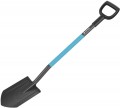Stiffening rib
The presence
of stiffeners on the shovel blade — longitudinal parallel protrusions. As the name suggests, these ridges increase the stiffness of the web, increasing its strength and flexural strength. This function is especially popular in models made of plastic (see "Web material") — this material itself is not very strong and bends easily, and additional reinforcement is very useful for it.
Blade length
The total length of the shovel blade. In the case of "digging" shovels (for example, bayonet, see "Form"), this size actually determines the depth to which you can dig at once; in the case of "loading" models (for example, scoops), the total area and, accordingly, the capacity of the canvas depends on the length.
It is worth noting that for each type of shovels there are certain standards for the size of the canvas. However, different models of the same type and shape can vary markedly in length. At the same time, if the length is too short, more movements will have to be done, and if the canvas is too large, it will be heavy and bulky and will require increased effort when working. Therefore, when choosing, it is worth considering the features of the intended application: for example, a relatively short blade will be enough for a small country flower bed, and a larger shovel will come in handy for working in a large garden. Recommendations for more specific tasks can be found in special sources.
Blade width
The total width of the shovel blade.
The value of this parameter will be different depending on what the shovel is used for — digging, loading / unloading bulk materials or snow removal. In the first case (for example, in bayonet shovels), the width of the pit being dug depends on the size of the canvas. It doesn't always have to be large, and a wide blade experiences more resistance, meaning a large shovel isn't always the best choice. For example, drainage cloths (see "Form") are initially made narrow.
In the second case (shovel shovels), a large width allows you to scoop up more cargo, however, this cargo will weigh accordingly. Therefore, here the difference between different models is most often not very large — most of the canvases have a width in the range of 220 – 260 mm.
In the third case (snow shovels and scrapers), the large width allows you to capture more snow at a time, which is convenient in large open spaces. But for difficult conditions with an abundance of narrow passages and tight nooks and crannies, it is better to choose a narrower tool that can go where a wide canvas does not fit.
Rubberized shaft
The presence of a rubberized handle in the design of the shovel.
Rubber by itself is too soft to be used as a base material for a pen. Therefore, in this case, most often means a
rubber pad on the handle. Such pads are designed to ensure that the handle is comfortable to hold, does not slip and does not cool the hands. They are found only in shovels with metal handles, made of aluminium or plastic (see "Shank material") — this function is not relevant for wooden handles (in particular, they are quite convenient on their own).
Shovel length
The total length of the shovel; for models with variable length (folding or telescopic, see above), the maximum size is taken into account, when unfolded to the maximum position.
In the case of full size shovels (garden shovels, construction shovels, snow shovels — see "Type"), the optimal length depends primarily on the height of the user. It is believed that a shovel, placed vertically, should be 10 cm below the shoulder joint; however, some prefer a shorter tool — up to the elbow. If you do not have the opportunity to “try on” the shovel “live”, you can measure the height to the desired point (10 cm below the shoulder or elbow) and, when choosing, compare this height with the length of the tool. Note that a shovel without a handle (see above) may well be somewhat longer than necessary — the “surplus” of the handle usually does not create any particular inconvenience. But in the presence of a handle, length matching is extremely important.
If we are talking about small shovels for tourist / automotive purposes, then here we should proceed from a compromise between efficiency and compactness. A shorter shovel will be more convenient to store and transport, but may be inconvenient and ineffective for heavy work (both because of the inconvenience in the hands and because of the short lever length, which requires considerable effort).
Weight
The total weight of the shovel; for models with a removable handle (wooden) it is specified taking into account the complete handle.
The lightweight tool reduces effort and therefore fatigue, allowing you to work faster and longer. At the same time, in some situations, just a lot of weight is more desirable: for example, a heavy bayonet shovel easily pierces even into dense earth and cuts the roots without any problems. In addition, weight loss often comes at a cost. Therefore, it makes sense to specifically look for a light shovel only when working with loose soil or materials where the blade does not have to be “driven” with force.

